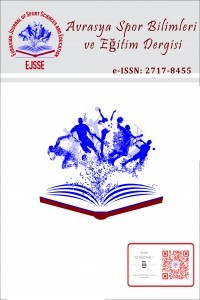Anaerobik Mesafe Kapasitesi Futbolda Hız, İvmelenme ve Çeviklik Üzerinde Etkili midir?
Anaerobik mesafe kapasitesi, Kritik hız, Çeviklik, Hız, İvme
Is Anaerobic Distance Capacity Effective on Speed, Acceleration and Agility in Football?
Anaerobic distance capacity, Critical velocity, Agility, Speed, Acceleration,
___
- Bull, A.J., Housh, T.J., Johnson, G.O., & Rana, S.R. (2008). Physiological responses at five estimates of critical velocity. European Journal of Applied Physiology, 102(6), 711-720. https://doi.org/10.1007/s00421-007-0649-7
- Denadai, B.S., Gomide, E.B.G., & Greco, C.C. (2005). The relationship between onset of blood lactate accumulation, critical velocity, and maximal lactate steady state in soccer players. The Journal of Strength & Conditioning Research, 19(2), 364-368. https://doi.org/10.1519/1533-4287
- Ettema, J.H. (1966). Limits of human performance and energy-production. Internationale Zeitschrift für Angewandte Physiologie Einschließlich Arbeitsphysiologie, 22, 45-54. https://doi.org/10.1007/BF00694796
- Florence, S. L., and Weir, J. P. (1997). Relationship of critical velocity to marathon running performance. European Journal of Applied Physiology and Occupational Physiology, 75(3), 274-278. https://doi.org/10.1007/s004210050160
- Gaesser, G.A., Carnevale, T.J., Garfinkel, A., Walter, D.O., & Womack, C.J. (1995). Estimation of critical power with nonlinear and linear models. Medicine and Science in Sports and Exercise, 27(10), 1430-1438. https://doi.org/10.1249/00005768-199510000-00012
- Hill, D.W. (1993). The critical power concept: A review. Sports Medicine, 16, 237-254. https://doi.org/10.2165/00007256-199316040-00003
- Hill, D.W., and Ferguson, C.S. (1999). A physiological description of critical velocity. European Journal of Applied Physiology and Occupational Physiology, 79, 290-293. https://doi.org/10.1007/s004210050509
- Housh, D.J., Housh, T.J., & Bauge, S.M. (1990). A methodological consideration for the determination of critical power and anaerobic work capacity. Research Quarterly for Exercise and Sport, 61(4), 406-409. https://doi.org/10.1080/02701367.1990.10607506
- Housh, T.J., Cramer, J.T., Bull, A.J., Johnson, G.O., & Housh, D.J. (2001). The effect of mathematical modeling on critical velocity. European Journal of Applied Physiology, 84(5), 469-475. https://doi.org/10.1007/s004210000375
- Jenkins, D.G., and Quigley, B.M. (1990). Blood lactate in trained cyclists during cycle ergometry at critical power. European Journal of Applied Physiology and Occupational Physiology, 61, 278-283. https://doi.org/10.1007/BF00357613
- Kaplan, T., Erkmen, N., & Taskin, H. (2009). The evaluation of the running speed and agility performance in professional and amateur soccer players. The Journal of Strength & Conditioning Research, 23(3), 774-778. https://doi.org/10.1519/JSC.0b013e3181a079ae
- Karsten, B., Larumbe-Zabala, E., Kandemir, G., Hazir, T., Klose, A., & Naclerio, F. (2016). The effects of a 6-week strength training on critical velocity, anaerobic running distance, 30-M sprint and Yo-Yo intermittent running test performances in male soccer players. PloS One, 11(3), e0151448. https://doi.org/10.1371/journal.pone.0151448
- Köklü, Y., Alemdaroğlu, U., Özkan, A., Koz, M., & Ersöz, G. (2015). The relationship between sprint ability, agility and vertical jump performance in young soccer players. Science & Sports, 30(1), e1-e5. https://doi.org/10.1016/j.scispo.2013.04.006
- Kramer, M., Thomas, E.J., & Pettitt, R.W. (2020). Critical speed and finite distance capacity: norms for athletic and non-athletic groups. European Journal of Applied Physiology, 120(4), 861-872. https://doi.org/10.1007/s00421-020-04325-5
- Kranenburg, K.J., and Smith, D.J. (1996). Comparison of critical speed determined from track running and treadmill tests in elite runners. Medicine and Science in Sports and Exercise, 28(5), 614-618. https://doi.org/10.1097/00005768-199605000-00013
- Little, T., and Williams, A.G. (2005). Specificity of acceleration, maximum speed, and agility in professional soccer players. The Journal of Strength & Conditioning Research, 19(1), 76-78. https://doi.org/10.1519/14253.1
- Meckel, Y., Machnai, O., & Eliakim, A. (2009). Relationship among repeated sprint tests, aerobic fitness, and anaerobic fitness in elite adolescent soccer players. The Journal of Strength & Conditioning Research, 23(1), 163-169. https://doi.org/10.1519/JSC.0b013e31818b9651
- Monod, H., and Scherrer, J. (1965). The work capacity of a synergic muscular group. Ergonomics, 8(3), 329-338. https://doi.org/10.1080/00140136508930810
- Moritani, T., Nagata, A., Devries, H.A., & Muro, M. (1981). Critical power as a measure of physical work capacity and anaerobic threshold. Ergonomics, 24(5), 339-350. https://doi.org/10.1080/00140138108924856
- Morton, R.H. (2014). A decline in anaerobic distance capacity of champion athletes over the years?. International Journal of Sports Science & Coaching, 9(5), 1057-1065. https://doi.org/10.1260/1747-9541.9.5.1057
- Penteado, R., Salvador, A.F., Corvino, R.B., Cruz, R., Lisbôa, F.D., Caputo, F., & De Lucas, R.D. (2014). Physiological responses at critical running speed during continuous and intermittent exhaustion tests. Science & Sports, 29(6), e99-e105. https://doi.org/10.1016/j.scispo.2014.02.003
- Raya, M.A., Gailey, R.S., Gaunaurd, I.A., Jayne, D.M., Campbell, S.M., Gagne, E., & Tucker, C. (2013). Comparison of three agility tests with male servicemembers: Edgren Side Step Test, T-Test, and Illinois Agility Test. Journal of Rehabilitation Research & Development, 50(7), 951-960. https://doi.org/10.1682/JRRD.2012.05.0096
- Sever, O., and Arslanoğlu, E. (2016). Agility, acceleration, speed and maximum speed relationship with age factor in soccer players. Journal of Human Sciences, 13(3), 5660-5667. https://doi.org/10.14687/jhs.v13i3.4152
- Sheppard, J.M., and Young, W.B. (2006). Agility literature review: Classifications, training and testing. Journal of Sports Sciences, 24(9), 919-932. https://doi.org/10.1080/02640410500457109 Taylor, S.A., and Batterham, A.M. (2002). The reproducibility of estimates of critical power and anaerobic work capacity in upper-body exercise. European Journal of Applied Physiology, 87, 43-49. https://doi.org/10.1007/s00421-002-0586-4
- Vanhatalo, A., Jones, A.M., & Burnley, M. (2011). Application of critical power in sport. International Journal of Sports Physiology and Performance, 6(1), 128-136. https://doi.org/10.1123/ijspp.6.1.128
- Vigne, G., Gaudino, C., Rogowski, I., Alloatti, G., & Hautier, C. (2010). Activity profile in elite Italian soccer team. International Journal of Sports Medicine, 31(05), 304-310. https://doi.org/10.1055/s-0030-1248320
- Young, W.B., James, R., & Montgomery, I. (2002). Is muscle power related to running speed with changes of direction?. Journal of Sports Medicine and Physical Fitness, 42(3), 282-288.
- Yayın Aralığı: Yılda 2 Sayı
- Başlangıç: 2019
- Yayıncı: Nazmi SARITAŞ
Yeme Problemi Olan Otizmli Bireylere Uyarlanmış Fiziksel Aktivite ve Beslenme Programı ile Müdahale
Manchester City’s Start of the Offensive Phase: A Lag-Sequential Analysis
James SCİCLUNA, Renzo KERR-CUMBO, Kemal GÖRAL, Ender ŞENEL
The Effect of Adapted Physical Activities on an Individual with Special Need’s Turn-Taking Skills
Bekir Erhan ORHAN, Aydın KARAÇAM, Arif ÇETİN
Yasin ERSÖZ, İrfan YILDIRIM, Rabia ZEYTUN
Alt Ekstremiteye Uygulanan Akut Titreşim Egzersizlerinin Denge Performansına Etkisinin İncelenmesi
Mehmet Şerif ÖKMEN, Emre ŞİMŞEK
Anaerobik Mesafe Kapasitesi Futbolda Hız, İvmelenme ve Çeviklik Üzerinde Etkili midir?
Muhammet Hakan MAYDA, Erdal ARİ
Neslihan AKÇAY, Hilal DOĞAN GÜNEY, Mahmut Esat UZUN, Aybala CEBECİK, Mustafa Şakir AKGÜL
Spor- Fitness Tesislerinde Algılanan Hizmet Kalitesinin Müşteri Sadakatine Etkisi
